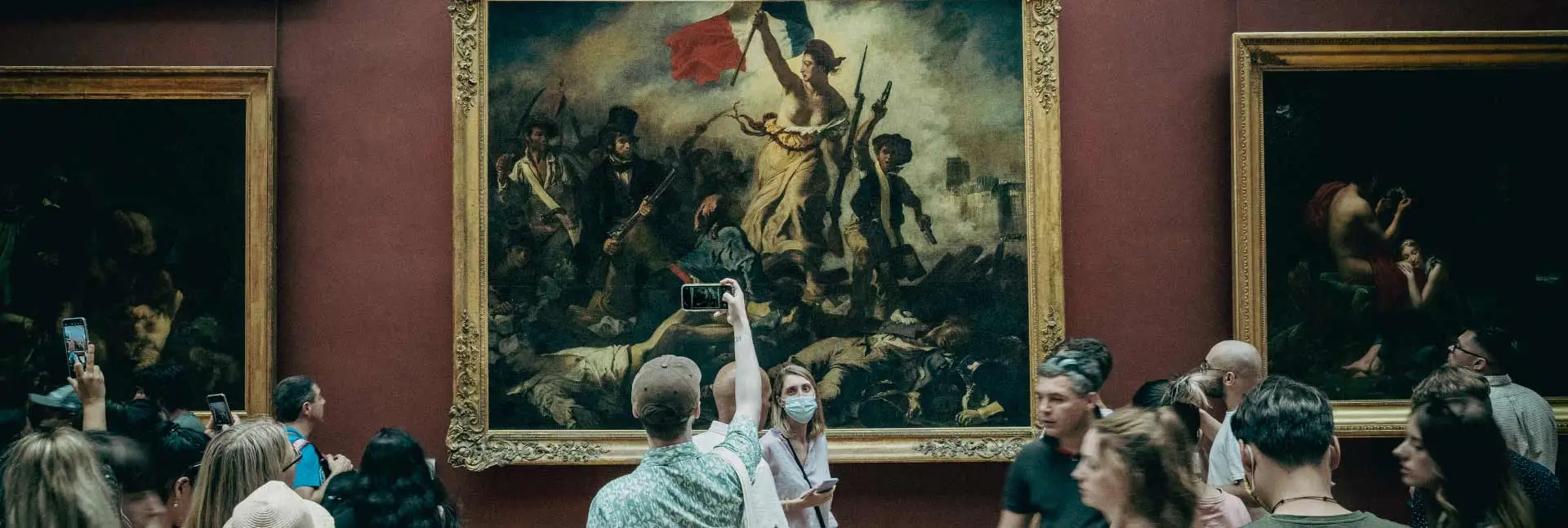
Guide to Visit the Louvre Museum: the 10 most important Works of Art
The Louvre Museum is a must-visit during your trip to Paris. Whether you are an art lover or not, it is definitely worth visiting. With over 35,000 pieces on display, choosing what to see can be overwhelming. That’s why we have prepared a guide to help you discover the 10 most important works in the Louvre Museum and make the most of your visit.
How to visit the Louvre Museum: the most important works of the Louvre
1.The Mona Lisa, the most famous face in the world
Leonardo da Vinci’s Mona Lisa is undoubtedly the most famous artwork in the Louvre. Its enigmatic smile, sfumato technique, and magnetism have made this painting a universal icon. If you visit Paris, you can't miss it—book your ticket to the Louvre Museum now.
Fun fact: It was stolen in 1911 and recovered two years later, further increasing its fame. Visit early, as it is one of the most crowded spots in the museum.
2. The Venus de Milo, eternal beauty
This ancient Greek sculpture, attributed to Alexandros of Antioch, is a symbol of classical beauty. The absence of her arms has only increased the mystery and fascination she inspires.
Take a moment to observe her posture and the harmony of her proportions, which represent the artistic perfection of her time.
3. The Winged Victory of Samothrace, art in motion
This masterpiece of Hellenistic sculpture depicts the goddess Nike (Victory) in mid-flight, with her garments flowing in the wind. Its placement at the top of a staircase makes it even more impressive.
It was discovered in pieces on the Greek island of Samothrace in 1863 and carefully restored to its former glory.
4. The Wedding at Cana, a monumental scene
This famous painting by Paolo Veronese is the largest in the Louvre and depicts Jesus' famous miracle of turning water into wine. Its richness in detail and the carefully represented characters make it a piece you could admire for hours.
Did you know that the artist painted himself into the artwork? Look for the musicians—the one wearing a white tunic with a viola da gamba is Paolo Veronese, but the rest of the band members are also artists, including Titian, Tintoretto, and Jacopo Bassano.
5. The Code of Hammurabi, law written in stone
Among the museum’s historical treasures is the Code of Hammurabi, a nearly two-meter-tall stone slab inscribed with laws from ancient Mesopotamia. This is one of the most important works in the Louvre, as it is one of the earliest examples of written law.
This piece is essential for understanding how ancient societies were organized and the role of justice in their structures.
6. The Coronation of Napoleon, a work of glory
Painted by Jacques-Louis David, this enormous work portrays the moment Napoleon Bonaparte crowned himself emperor in a lavish ceremony. Every detail was designed to glorify the leader and solidify his image as a sovereign.
Look for historical figures such as Josephine and Pope Pius VII. This painting demonstrates how art has historically been used as a political tool, making it one of the most important works in the Louvre Museum in Paris.
7. Liberty Leading the People, a symbol of revolution
Eugène Delacroix captures the spirit of the French Revolution in this painting. The central figure, representing Liberty, leads the people while holding the tricolor flag. This is a work full of emotion and symbolism, making it one of the most important in art history.
It remains a symbol of struggle and social change, inspiring movements throughout history.
8. The Sitting Scribe, a glimpse of ancient Egypt
The Louvre’s Egyptian collection includes stunning pieces, and one of the most remarkable is The Seated Scribe, a sculpture that surprises with its realism despite its age. Its glass eyes seem to look at you with a life of their own.
Notice the details of his posture and expression, which reflect the importance of scribes in ancient Egyptian society.
9. The Raft of the Medusa, tragedy turned into art
This masterpiece by Théodore Géricault is a shocking depiction of a real event: the shipwreck of the French frigate Méduse in 1816. The composition captures the struggle for survival and the despair of the castaways.
Géricault conducted extensive research, including visits to hospitals and morgues, to portray the scene with the utmost realism.
10. The Crown Jewels, a glimpse of history
In the section dedicated to decorative arts, the French Crown Jewels are on display, showcasing the luxury and opulence of French monarchies.
Take a moment to admire the intricate details of the crowns and tiaras, which tell the story of a majestic past. This collection is one of the most important in the Louvre Museum.
The Louvre Museum in Paris: Its Masterpieces Don't End Here
Choosing just 10 works from the Louvre Museum is almost impossible, as this museum is a veritable treasure chest. Other pieces that also deserve your attention are, The Horses of Marly, imposing equestrian sculptures, The Lion of Monsoon, an extraordinary example of Assyrian art, Portrait of a Young Girl, by Petrus Christus, an interesting sample of Flemish art, The Dying Slave, one of Michelangelo's moving sculptures, The Lacemaker, by Vermeer, a delicate work full of intimacy, The Oath of the Horatii, by Jacques-Louis David, a symbol of neoclassicism and many others that we cannot mention in a single post, you must visit them!